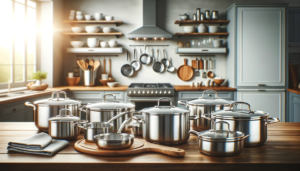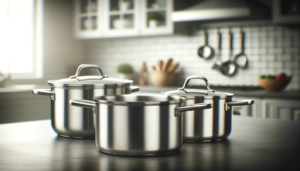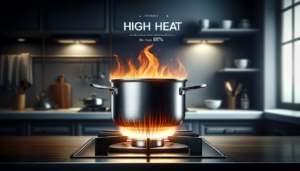Have you ever opened your kitchen cabinets and wondered if stacking all those stainless steel pots and pans might lead to dents or scratches?
While stacking stainless steel cookware in kitchen storage can save space, understanding the right and wrong ways to pile items together helps avoid long term damage.
Let’s take a deeper look at the pros and cons of stacking pots, pans and other vessels to make informed decisions…
Can You Stack Stainless Steel Cookware?
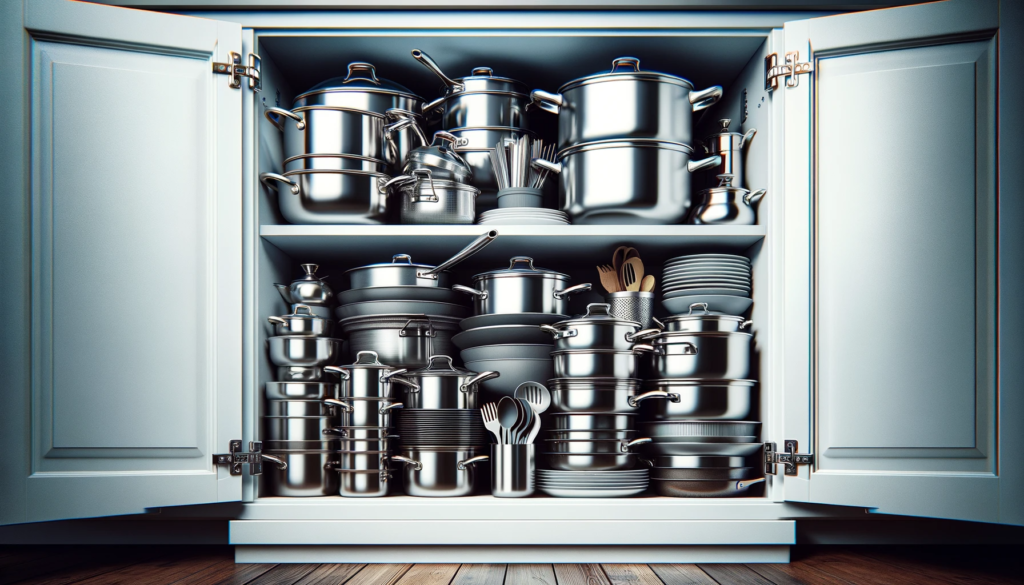
Yes, you can safely stack stainless steel cookware, however there are some best practices to follow.
Avoid stacking very heavy cookware that could dent softer metal, allow hot pans to fully cool before stacking, and use padding like dish towels between pieces to prevent scratches.
Be cautious of excess weight bearing down in deep piles.
We’ll explore more dos and don’ts of cookware stacking throughout this article.
Is It Safe to Stack Stainless Steel Pots and Pans?

Stacking lightweight stainless steel pots and pans is usually fine and causes no issues.
However, heavier stainless steel cookware can potentially cause dents or damage if stacked high and bearing a lot of cumulative weight.
Additionally, it is not recommended to stack very hot pots or pans that were recently used for cooking.
The high heat exposure can soften and weaken the stainless steel, causing dents when other items are stacked on top.
In general, moderately stacking cooler stainless steel is safe, but use care when stacking larger batches of heavy cookware.
Pros Of Stacking Stainless Steel Cookware
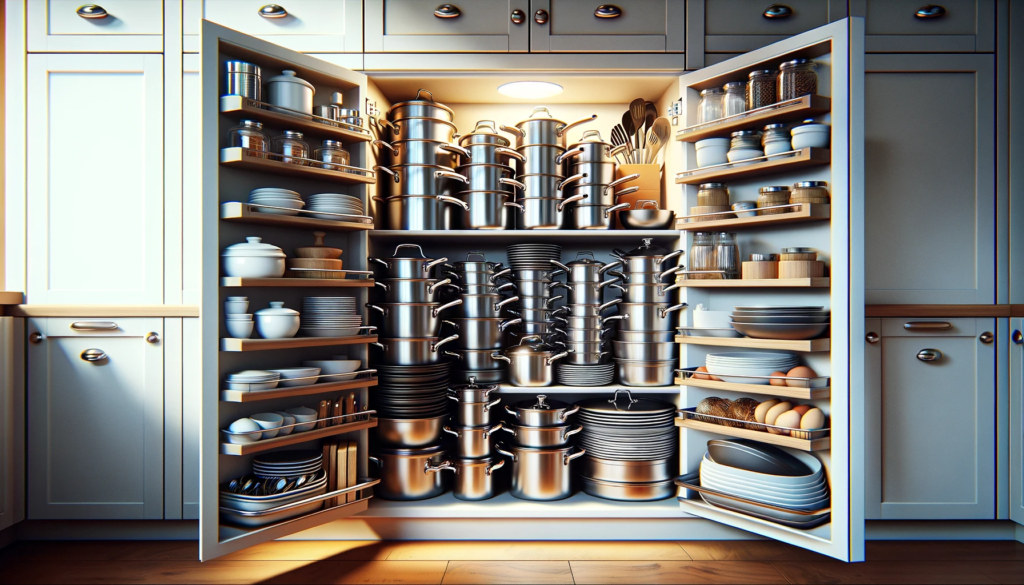
Saves Cabinet and Storage Space
Stacking pots and pans allows you to consolidate them into a smaller footprint inside kitchen cabinets.
Rather than all the cookware laying single-file and taking up the full cabinet depth, stacking them makes full use of the vertical storage space.
This frees up room for other items like baking sheets, cutting boards, and lids to also fit into the cabinets neatly.
It also provides more clearance to comfortably reach over and access items in the back.
Keeps Pots and Pans Organized Together
Having cookware stacked together keeps all the pieces consolidated as sets, as opposed to spread far apart inside cabinets.
Things like pot and pan sets often have corresponding lids that fit each piece.
Keeping them stacked makes it easier to keep track of which lid goes with which vessel.
It also allows you to see all the pieces you have together at a glance, taking stock of any duplicates or gaps you might have for upgrading your collection.
Allows You To See All Your Cookware At A Glance
When pots and pans lay flat, you can only see the topmost item or two in a cabinet, with everything else layered underneath in partial or full obscurity.
But stacking items provides full visibility down through the stacks, allowing you to see everything you have in your arsenal with just a quick peek without removing anything.
This makes it faster and easier when grabbing a specific pot or pan for a recipe, seeing all your options at once.
It also helps do a mental inventory of which pieces see frequent use versus items that rarely or never get touched.
Cons Of Stacking Cookware
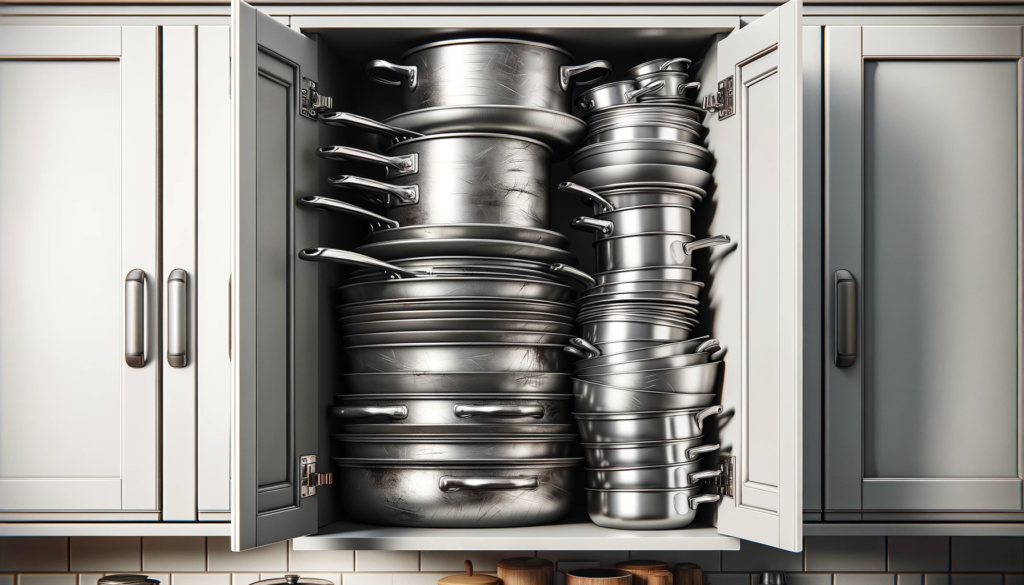
Heavy Stacks Can Lead To Dents And Damage Over Time
While stainless steel cookware is durable, it is still susceptible to warping and denting from significant pressure and weight.
When heavy stock pots or Dutch ovens are stacked with other heavy items on top, the cumulative weight can bend or crimp the sides of pots and pans near the bottom of a pile.
Over months and years of storage, permanent dents and marks can accumulate from stationary stacking pressure.
These dents may be purely cosmetic damage, but badly warped cookware can warp bottoms as well, leading to uneven heating performance.
Items On Bottom Can Get Scratched By Items On Top
The bottommost item in any stack bears the brunt of scuffs and scratches from above.
When removing and replacing pieces from a tall stack, rubbing and grinding against other cookware leaves tiny surface scars.
While stainless steel does not actually “scratch” given its hardened surface, scuff marks from abrasions negatively impact appearances.
And should any stack include non-stainless pans like ceramic coated or enameled vessels, their softer surfaces are prone to true scratching damage.
Harder To Remove An Individual Item From A Tall Stack
Accessing a single pot or pan within a dense, tall stack often requires removing the majority of pieces above first to reach lower levels safely.
This disturbance when grabbing just one item then necessitates restacking everything neatly again afterward.
For very deep stacks within cabinets, removing an item from the bottom would require clearing everything out first.
This inconvenience makes some cooks less prone to rotating out different pieces, instead reaching for items always kept conveniently on top of stacks.
Tips For Safe Stacking
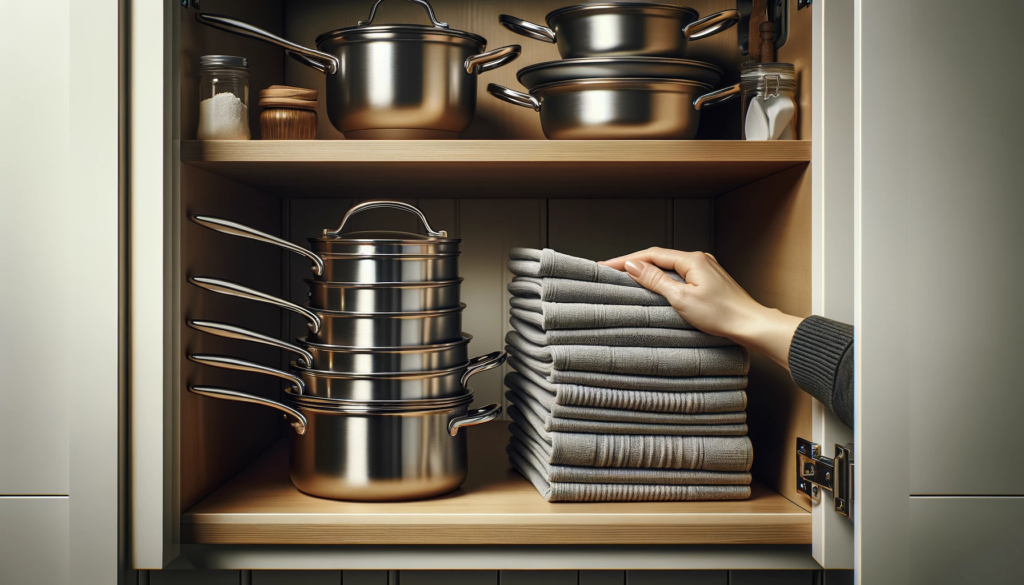
Place Soft Dish Towels Between Pots And Pans When Stacking
Lining each pot or pan with a folded dish towel before stacking provides a protective barrier.
This cushioning prevents direct contact between stainless steel surfaces, guarding the cookware from dents, scratches and scuffs.
Just reuse the same set of towels reserved specifically for this kitchen storage purpose rather than soiled towels previously used for drying.
Be sure to launder them periodically since they still collect dust and debris over time.
Keep The Heaviest Items On The Bottom Of Stacks
Having lighter stainless steel pieces like saucepans, stock pots and skillets on top with heavier Dutch ovens and roasting pans below is safest.
This avoids placing too much collective weight and pressure on the structural integrity of cookware near the bottom.
It also reduces the change of dents or warping occurring when removing pieces from the middle of tall stacks by mistake instead of lifting from the top.
Avoid Stacking Hot Cookware That May Weaken And Dent
Allow pots and pans to fully cool before stacking, as hot metal is more malleable from cooking temperatures.
Stacking cooler pieces first provides a more study base to build upward, while very hot pots or pans risk losing their shape under stacking loads.
Ensure cookware feels just faintly warm to the touch prior, indicating it has normalized back to room temperature.
Avoid extremes like freezer-cold metal as well, which becomes more brittle.
Store Lids Separately Or Stacked Evenly To Prevent Scratching
Rather than stacking lids intermingled with pots and pans, keep them stored together as their own neat pile.
The mix of sizes and shapes when tossed together leads to lid handles and knobs catching on cookware surfaces, creating scratches.
Or alternate stacking lids facing up then facing down to distribute contact pressure across the entire lid surface rather than concentrated on handles.
Types Of Items Not To Stack
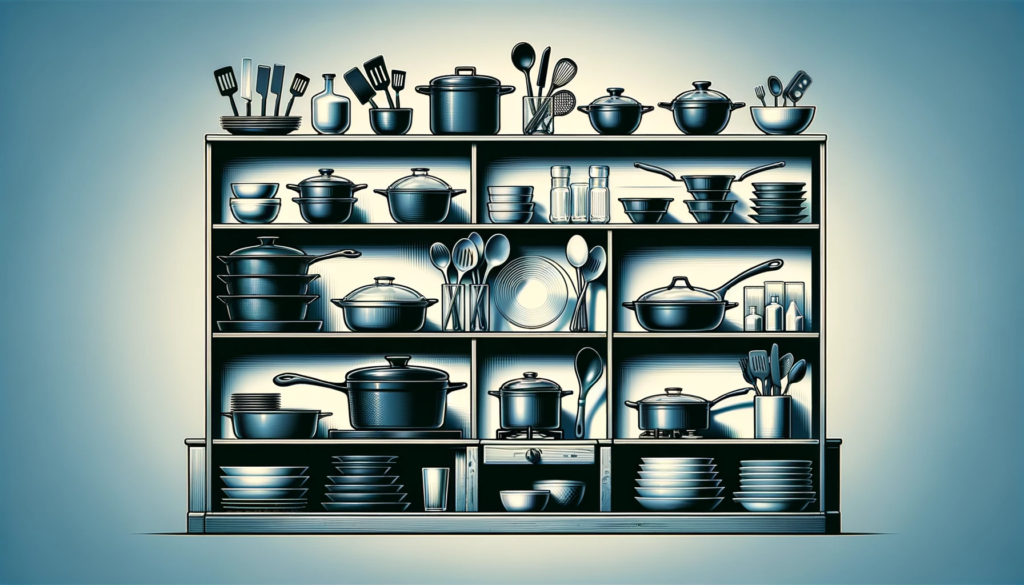
Cast Iron Pans (Very Heavy)
While extremely durable under heat, cast iron is prone to cracking under heavy impact pressure.
Dropping or bottoming out thick cast iron pans and Dutch ovens risks hairline fractures or outward chipping damage.
And when stacked for storage, their dense weight can permanently warp other cookware below.
Cast iron requires gentle care more akin to delicate ceramic and glassware.
Non-Stick Cookware (Delicate Surface)
The non-stick surfaces on ceramic, titanium and Teflon cookware can scratch, chip or peel when items rub and grind together.
Only stack non-stick pieces with other non-stick items to avoid stainless steel damaging their coating.
Avoid overloading too many non-stick pans together, keep stacks shallow with soft dividers between each piece.
Handle non-stick cookware more gingerly overall compared to stainless.
Crystal And Glass Baking Dishes
Despite their apparent sturdiness, items like glass casserole dishes and Pyrex containers have delicate structural integrity prone to shattering.
The vulnerability comes from nick points that propagate outward into cracks from impacts.
Stacking puts localized pressure against other hard surfaces that can chip glass or crystal edges.
Play it safe keeping these items stored separately on cabinet shelves.
Items Still Hot From The Oven Or Stovetop
As mentioned earlier, allowing cookware to fully cool down to room temperature before storage maintains proper structural integrity under pressure.
Stacking onto very hot items risks dents or gaps between the metal layers of cookware bottoms that undermine performance.
Always give recently heated pans a chance to stabilize before stacking together with other pieces.
Conclusion
In closing, stacking stainless steel cookware can be safe when done properly, but does come with some risks of scratches, dents or other damage over time.
Use protective liners between pots and pans, keep heavier items on bottom, allow pieces to fully cool after cooking, and avoid stacking certain delicate items like glass or cast iron.
Be cautious of excess weight bearing down when stacking a deep mix of bulky cookware.
Employ common sense based on your particular collection and storage space.

